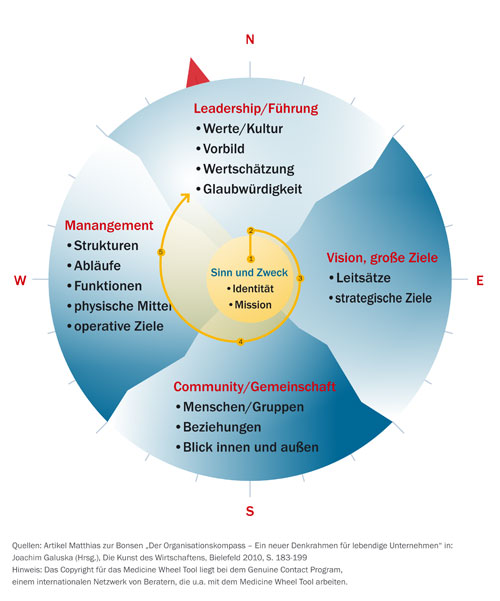At the centre>the purpose of existence: Are we aware of our basic passion? Do we see an additional higher purpose? In how far is our basic passion alive?
In the North>the executives/the management: are they courageous, do they tread new paths and implement changes? Do they have an idea of the future and communicate it?
Do they inspire others to follow the idea? Do they create conditions under which people can develop positively? Do they instruct the development of strategies? Are they driven/guided by values like esteem, honesty, straightforwardness and do they spread them throughout the company by being a role model? In the original wheel of medicine, the North represents the warrior and vitality.
In the East> the great goal/the vision: What is the common goal? – What is the next big goal? How is it connected to the purpose of existence and the values? Does the goal come from the inside and is it really wanted? How does the picture look like when everything is finished? How strong is the conviction to achieve this goal? In the original wheel of medicine, the East represents the seer.
In the South> the community: This element opposes the management. It is about the people guided. In how for is the organization a strong community? Is everybody a part of the whole and responsible for the whole? In how far does the individual feel obliged? In how far do the people support each other? Does everybody have access to information? In the original wheel of medicine, the South represents the healer.
In the West> the liberating structures/professional management: Which structures, systems, processes and practices are there? Are these structures wise instead of restrictive?In the original wheel of medicine, the West represents wisdom.
The diagonals>relationships, connections and the flow of information: They interconnect all elements and groups. How good are the meetings and the flow of information?
All 6 aspects (centre, quadrants and diagonals) contribute to create a change-friendly organization with spirit and the love of life. The North-South axis emphasises the human factor, the West-East axis emphasises the factor of things. The historical roots of the organization compass lie in the Native American wheel of medicine. It forms the basis of the integral view of the human and the environment, that change is the single constant thing and that mutual closeness and dependence is a vital principle. The Open Space progressive thinker Harrison Owen was the first to transfer a converted version of the wheel of medicine to organizations.
Sources: “Der Organisationskompass in der Praxis“ (Buhl-Böhnert, Schönberg, 2015), Artikel
Matthias zur Bonsen, “Der Organisationskompass - Ein neuer Denkrahmen für lebendige Unternehmen“ in: Joachim Galuska (Hrsg.), Die Kunst des Wirtschaftens, Bielefeld 2010 S. 183-199
Download_Organization_Kompass (PDF)

